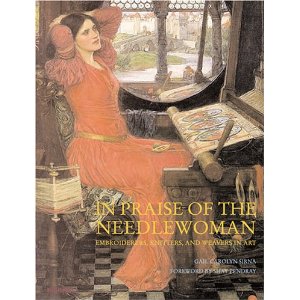
By Gail Carolyn Sirna
Foreword by Shay Pendray
Merrell Publishers, New York, 2006
ISBN 1 85894 341 8
187 pages plus further reading, picture credits, index, and acknowledgments
Click the image to see more on Amazon.com
Review by Denise Beusen:
This new book by first-time author Gail Carolyn Sirna is a compendium of paintings that show women engaged in textile arts. Her motivating assertion is that needlework is second only to childbirth and childrearing as a common thread that links women of all places, cultures, and eras. For each painting, she provides a brief commentary about its composition, what the physical setting of the female subject tells us about her life situation, and the historical context of other elements of the picture.
Ms. Sirna has taught needlework for 30 years, is an award-winning embroiderer, and is a regular columnist for Needlepoint Now. In 2004 she received a Lifetime Achievement Award from the National Academy of Needlearts (NAN). In Praise of the Needlewoman started as a lecture presented for needlework guilds. It evolved over time as the focus for the author’s Honors Teaching Certification through the National Academy of Needlearts, and finally has come to maturity in the form of this book. En route, the author researched the collections of museums in North America and Europe to identify relevant paintings from the 15th through the 20th centuries. She indicates in her introduction that these investigations yielded nearly 500 such paintings. This text presents approximately 90 of them, although the criteria for their selection are not provided.
The paintings are presented chronologically by date of creation. Each painting is given a full page, with the artist, title, date of creation, and source of each painting presented below the image. The author’s narrative is on the opposite page; the writing is straightforward, objective, and highly readable. In some cases, the painting is repeated as a monochromatic halftone screen under the written narrative. This is a particularly effective design feature that enhances the visual presentation without compromising the readability of the text. The color reproductions are of a very high quality; in fact, given their number, the nominal price of $35 seems very reasonable. The table of contents does not list the paintings individually, however they are indexed by artist at the end of the book.
The dimensions of this hardcover book (approx. 8½ x 11″) are entirely consistent with the intimate tone of the book. It can be comfortably held in one’s hands for reading or scanning, but at the same time its size provides enough page area to do the paintings justice. Although a number of previous texts have detailed the history of needlework from a variety of different perspectives, this book offers a novel approach. The coupling of the paintings with a short narrative gives an immediacy to their historical context that can be difficult to extract from more conventional presentations.
This book is unlike anything else in my library. It’s one of the few books I’ve owned
from which I get guilty pleasure – it sits on my family room table, like a box of chocolates. During the course of my busy day, I find myself stealing moments in which I pick up the book and randomly peruse a picture or two along with its commentary. In doing so, I am instantaneously transported into the place that stitching always takes me – a focused meditation.
In Praise of the Needlewoman is both visually and intellectually enjoyable. It would be a good addition to the library of anyone with an interest in the arts, needlework, women’s history, or art history.
